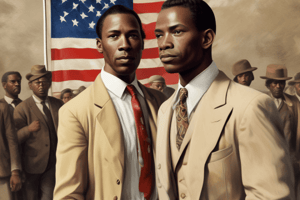Podcast
Questions and Answers
What was the outcome of the Plessy vs Ferguson case?
What was the outcome of the Plessy vs Ferguson case?
- Integration of public transportation
- Separation of church and state
- Segregation in public education (correct)
- Desegregation in public education
What was the name of the court case that overturned Plessy vs Ferguson?
What was the name of the court case that overturned Plessy vs Ferguson?
- Brown vs Board of Education (correct)
- The Civil Rights Act
- Martin Luther King Jr vs The State
- Rosa Parks vs Alabama
Why did it take so long for schools to desegregate?
Why did it take so long for schools to desegregate?
- The government did not give schools a deadline to desegregate (correct)
- The government didn't provide sufficient funding
- The Supreme Court was slow to make a decision
- There was a lack of public support
What did Rosa Parks refuse to do?
What did Rosa Parks refuse to do?
What was the result of the Montgomery Bus Boycott?
What was the result of the Montgomery Bus Boycott?
What did Dr. Martin Luther King Jr believe in?
What did Dr. Martin Luther King Jr believe in?
What is Ronald Reagan most known for?
What is Ronald Reagan most known for?
What role did Ronald Reagan play in the Cold War?
What role did Ronald Reagan play in the Cold War?
What did perestroika allow in the Soviet Union?
What did perestroika allow in the Soviet Union?
What was the ultimate goal of the Civil Rights Act?
What was the ultimate goal of the Civil Rights Act?
Study Notes
Civil Rights Movement
- Plessy vs Ferguson (1896) allowed "separate but equal" education, leading to segregation in public education
- Brown vs Board of Education (1954) overturned Plessy vs Ferguson, but schools were slow to desegregate due to lack of government deadlines
- Rosa Parks' defiance in 1955 led to the 381-day Montgomery Bus Boycott
- Dr. Martin Luther King Jr. advocated for peaceful protest and social change without violence
- The March on Washington (1963) resulted in leaders meeting with the President, ultimately leading to the Civil Rights Act of 1964
- The Civil Rights Act ended discrimination based on race, color, religion, sex, or national origin, ensuring equal access to public accommodations and fair job hiring practices
Reagan Era
- Ronald Reagan is known for his economic policy, "Reaganomics"
- Reagan played a key role in ending the Cold War
- Before presidency, Reagan was an actor and Governor of California
Post-Cold War
- Perestroika (Economic Restructuring) allowed ordinary people to have more control over Russian businesses and own their own businesses again
- Glasnost (Openness) gave people freedom of speech in the Soviet Union
- Reagan's "Peace through Strength" strategy involved having the best weapons to deter attacks, making others afraid to attack
- The Intermediate-range Nuclear Forces Treaty (INF) was signed by the US and Russia, eliminating INF and promising not to attack each other
- The US maintained its powerful defensive weapons but pledged not to use them
Civil Rights Movement
- Plessy vs Ferguson (1896) allowed "separate but equal" education, leading to segregation in public education
- Brown vs Board of Education (1954) overturned Plessy vs Ferguson, but schools were slow to desegregate due to lack of government deadlines
- Rosa Parks' defiance in 1955 led to the 381-day Montgomery Bus Boycott
- Dr. Martin Luther King Jr. advocated for peaceful protest and social change without violence
- The March on Washington (1963) resulted in leaders meeting with the President, ultimately leading to the Civil Rights Act of 1964
- The Civil Rights Act ended discrimination based on race, color, religion, sex, or national origin, ensuring equal access to public accommodations and fair job hiring practices
Reagan Era
- Ronald Reagan is known for his economic policy, "Reaganomics"
- Reagan played a key role in ending the Cold War
- Before presidency, Reagan was an actor and Governor of California
Post-Cold War
- Perestroika (Economic Restructuring) allowed ordinary people to have more control over Russian businesses and own their own businesses again
- Glasnost (Openness) gave people freedom of speech in the Soviet Union
- Reagan's "Peace through Strength" strategy involved having the best weapons to deter attacks, making others afraid to attack
- The Intermediate-range Nuclear Forces Treaty (INF) was signed by the US and Russia, eliminating INF and promising not to attack each other
- The US maintained its powerful defensive weapons but pledged not to use them
Studying That Suits You
Use AI to generate personalized quizzes and flashcards to suit your learning preferences.
Description
This quiz covers the key events and figures of the US Civil Rights Movement, including the Plessy vs Ferguson and Brown vs Board of Education court cases, and the role of Rosa Parks in the fight against segregation.




